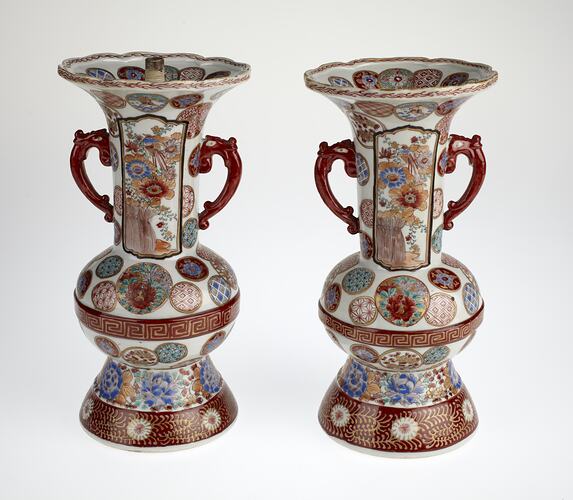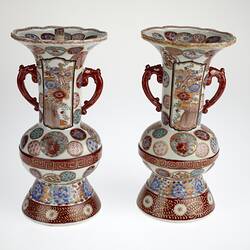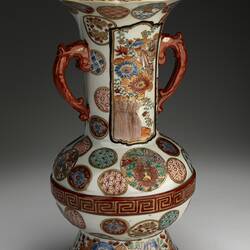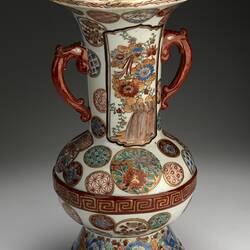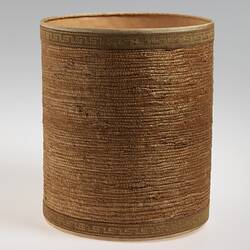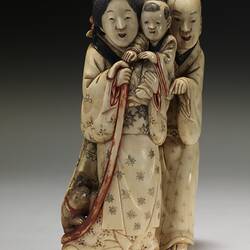Summary
Imari ware vase (one of a pair) created by Hichozan Shinpo in Arita, Saga Prefecture, Japan, during the late Edo or early Meiji Period, 1856-1880. The signature on the vase reads Hichozan Shinpo Zou (made by Hichozan Shinpo) and indicates that it was produced by the Tashiro firm, which used this marking, and the similar 'Hichozan Shinpo Sei' to denote items produced from approximately 1856 onwards, made exclusively for the Western export market.
Imari porcelain ware takes it name from the port-city of Imari in the Saga Prefecture on the southern island of Kyushu, Japan. From the late 17th century, Imari porcelain was extensively exported specifically for the European market. In Japan, this type of porcelain is also referred to as Arita-yaki, as much of it is made in the town of Arita in the Saga Prefecture.
The vase dervives its form from Chinese Ming dynasty (1368-1644) copper ware, particularly a similar shaped vessel of the Wan-li era (1573-1620) used as a wine bottle. The use of the chrysanthemum flower as a decorative motif is common to both Chinese and Japanese art.
The Japanese firm Tashiro was established by trading merchant Tashiro Monzaeman (1816-1900) in the late Edo period, mid-1850s. He established branches in Nagasaki, Yokohama, Shanghai, even in New York and monopolized trade through until the 1870s. Products by Tashiro & Co. were exhibited at the Paris World Exposition in 1867, and Tashiro Monzaeman was responsible for the exhibition of Arita ware at the 1873 Vienna International Exhibition, which helped further strengthen an export market for this particular type of ceramic ware.
The Japanese firm Koransha exhibited Imari ware at the 1880 Melbourne International Exhibition. The Koransha Factories were established at Arita in 1875 by Eizaemon Fukagawa, of the well-established Fukagawa family of ceramists, for the purpose of producing porcelain ware for the Western export market. The company subsequently won a certificate of merit at the Philadelphia Centennial Exposition in 1876, and a gold prize at the 1878 Paris Universelle Exposition. They exhibited Arita porcelain bowls, flower-vases - such as this one - and tea sets in Melbourne in 1880.
Physical Description
Large, flower rim, cylindrical neck, bulbous body and flaring foot. Two handles affixed to neck. Off-white ground, decorated all over with roundels painted with stylised flowers. Inside lip similarly decorated. Two vertical panels, painted on opposite sides of neck with glowers and waterfall scene. Vase has been converted for use as a lamp stand. It has been filled with plaster and has had a hole drilled in the base.
More Information
-
Collection Names
-
Collecting Areas
-
Acquisition Information
Cultural Gifts Donation from Dr Will Twycross, 23 Jan 2009
-
Acknowledgement
Donated through the Australian Government's Cultural Gifts Program
-
Place & Date Made
-
Place & Date Exhibited
Royal Exhibition Building (REB), Carlton, Greater Melbourne, Victoria, Australia, 1880-1881
-
Collector
Mr John Twycross, Elsternwick, Greater Melbourne, Victoria, Australia, 1881
-
Inscriptions
Kanji painted on underside in red: Hichozan Shinpo Zou (made by Hichozan Shinpo)
-
Classification
Royal exhibition building, International exhibitions, Exhibition heritage
-
Category
-
Discipline
-
Type of item
-
Overall Dimensions
115 mm (Width), 250 mm (Height)
-
Maximum dimensions
253 mm (Height), 358 mm (Circumference)
Measurement From Conservation.
-
References
-
Keywords
Decorative Arts, Exhibitions: Melbourne International, 1880-1881, Japanese Art, Royal Exhibition Building
